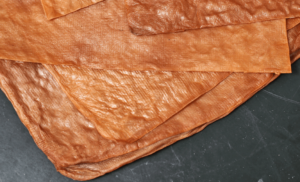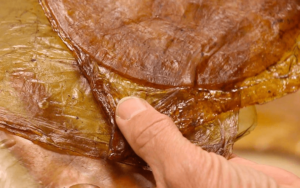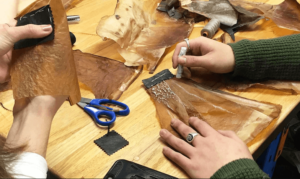A Details Guide To Scoby Leather Fabric

Ammy Harryy, a devoted advocate for sustainable fashion and mindful…
Have you ever seen something and thought to yourself, “How can that be made?” I know I have.
That’s the reaction I had when seeing scoby leather for the first time. Scoby is a textile material made from the bacterial cellulose of bacteria grown on fermented substrates such as sugars or starches.
What does that mean? In short, it means scoby leather is a sustainable, biodegradable, and environmentally friendly material perfect for eco- and fashion-conscious consumers.
Read on to learn more about this innovative new material!
What is Scoby Leather?
Scoby leather, also known as kombucha leather, is a type of vegan leather made from kombucha tea.
Unlike traditional leather, which is made from the skin of an animal, scoby leather is made by drying kombucha tea until it forms a Leather-like material.
The kombucha leather can then be used to create clothing, accessories, and other items.
While kombucha leather is a relatively new material, it has already begun to gain popularity in the fashion industry.
Thanks to its eco-friendly credentials and stylish appearance, kombucha leather is being used by a growing number of fashion brands.
What’s more, kombucha leather is also durable and easy to care for, making it an appealing alternative to traditional leather.
If you’re looking for a sustainable and chic way to style your wardrobe, kombucha leather is definitely worth considering.
With its growing popularity, it’s only a matter of time before kombucha leather becomes a mainstay in the fashion world.
History of Scoby Leather
The history of Scoby leather begins with Suzanne Lee, a British fashion designer who began exploring the possibilities of using bacterial cellulose as a textile in 2003.
After several years of experimentation, she succeeded in creating a material that she dubbed “bacterial cellulose” or “Scoby leather.”
The material is made by culturing bacteria in a sugary solution, which causes the bacteria to produce cellulose.
The cellulose is then harvested and processed into a thin, flexible sheet that can be used to create clothing and other textile products. The particles left in the kombucha bottle are actually the pieces of thin layer.
Today, Scoby leather is still produced primarily by hand, although there are a few companies that have begun to experiment with industrial-scale production methods.
While the material is not yet widely available, it has gradually gained popularity among fashion designers and eco-conscious consumers.

How Sustainable is Scoby Leather?
Scoby leather is a sustainable and eco-friendly alternative to traditional leather. It is made from symbiotic cultures of bacteria and yeast (SCOBYs) which are dried into a thin sheet.
The SCOBYs are a by-product of the kombucha brewing process and would normally be discarded. However, they can be repurposed to make scoby leather.
The drying process is relatively simple. First, the SCOBYs are placed on a flat surface and left to dry.
Once they are dry, they are then turned into a thin sheet. This sheet can be used to make wallets, purses, and other leather goods. Scoby leather is strong and durable, yet flexible and soft to the touch.
It is also water-resistant, making it an ideal material for outdoor use.
Scoby leather is a sustainable alternative to traditional leather because it uses an otherwise wasted product.
It is also environmentally friendly because it does not require the harming of animals or the use of toxic chemicals.
If you are looking for a sustainable and eco-friendly alternative to traditional leather, scoby leather is a great option!
What makes Scoby leather a Sustainable Option?
What makes Scoby leather a sustainable option? It all starts with the fermentation process.
Scoby is the acronym for Symbiotic Culture of Bacteria and Yeast, and it’s the key ingredient in kombucha. To make kombucha, you need a starter kombucha (which contains the Scoby) and sweet tea.
The fermentation process takes about a week, during which time the Scoby consumes the sugar in the tea, leaving behind a slightly alcoholic, effervescent beverage.
The fermentation process also creates a byproduct: Scoby leather. This material is created as the Scoby breaks down the cellulose in the sweet tea.
It’s similar to vegetable leather or pleather, but it has a unique fermentation-based texture that makes it ideal for use in fashion and accessories.
The fashion industry is responsible for a significant amount of pollution, so finding sustainable materials is essential.
And that’s where Scoby leather comes in. Because it’s made from a byproduct of fermentation, it doesn’t require any additional resources or energy to produce. And since it can be made from locally sourced ingredients, it helps to reduce your carbon footprint.
In addition, Scoby leather is biodegradable and compostable, so it won’t add to landfill waste.
So if you’re looking for a sustainable alternative to traditional leather, Scoby leather is definitely worth considering. It’s eco-friendly, durable, and stylish – what more could you ask for?
How is Scoby Leather turned into a Fabric?

Scoby leather is a water-resistant fabric made from kombucha scoby, the cellulose-rich material leftover from brewing kombucha.
To make scoby leather, tea bags are soaked in kombucha and then dried. The resulting material is strong and flexible, making it well suited for a variety of uses.
Scoby leather is often used to make clothing, bags, and other accessories. Its water-resistant properties make it ideal for use in wet or humid environments
In addition, scoby leather is naturally antibacterial, making it an ideal material for use in medical applications.
The Pros of Scoby leather
Scoby leather is a zero waste product that is made from the byproduct of brewing kombucha.
It is a rubbery, plastic-like material that can be used to make eco-friendly fashion accessories and home decor items.
Unlike traditional leather, scoby leather is waterproof and does not require any treated with chemicals or oils.
It is also very easy to clean; simply wiping it down with a solution of water and rubbing coconut oil will suffice on the wooden board.
In addition, scoby leather is very strong and durable, making it an ideal material for items that see a lot of wear and tear.
Best of all, scoby leather is completely biodegradable, so it will not contribute to landfill waste. If you are looking for an environmentally friendly alternative to traditional leather, scoby leather is definitely worth considering.
The Cons of Scoby leather
Scoby leather is a material made from the ellagitannins of scobys, which are the remnants of fermented beverages.
While it has some benefits, there are also some drawbacks to consider. One of the biggest drawbacks is that scoby leather is not very strong.
It tears easily and is not great for holding heavy items. In addition, because it is made from a natural product, it is subject to mold and mildew growth.
Scoby leather also tends to be more expensive than other types of leather. Finally, it is important to note that scoby leather is not vegan-friendly as it contains animal products.
Scoby Leather Clothing Brand
Scoby is a type of vegan leather made from the kombucha culture, also known as a SCOBY.
This material is starting to gain popularity among eco-conscious consumers and sustainable fashion brands.
Here are some clothing brands that use Scoby leather in their products:
1. Brave GentleMan
2. Mata Traders
3. Reformation
4. Ethletic
5. Will’beth
6. Giadzy
7. Bead & Reel
8. Studio Jux
9. Olive Clothing
10. Svala
The Impact of Scoby Leather

Scoby leather is a type of cover made from dried scoby, which is a by-product of the kombucha brewing process.
While it may look like animal leather, it is actually entirely vegan and environmentally friendly.
Scoby leather can be used to cover anything from books to furniture, and it can also be dyed any color you like.
One of the best things about scoby leather is that it is extremely durable and will last for many years with proper care. In addition, it is very easy to clean and maintain.
If you are looking for a unique and sustainable alternative to animal leather, scoby leather is a great option.
Impact of Scoby leather on animals and people
Scoby leather is a type of material made from the skin of a kombucha culture. It is commonly used in the production of shoes, belts, and other leather goods.
While Scoby leather is a durable and long-lasting material, it does have some potential drawbacks.
One concern is that the tanning process used to treat Scoby leather can release harmful chemicals into the environment.
Additionally, Scoby leather may contain toxins that could be harmful to animals or humans if ingested. As a result, it is important to research any potential health risks before using Scoby leather products.
Conclusion
If you’re looking for an environmentally friendly alternative to traditional materials like plastic or leather, scoby leather may be the perfect option for you.
The process is simple and the end result is versatile and durable.
Have you tried making scoby leather? What other uses have you found for it?
More Sustainable Guide You’ll Love to read:
Apple Leather Fabric Guide (Everything You Want to Know)
Sustainable Viscose Fabric Material Guide
Seacell Fabrics Material Guide For Fashion Designer
Cork leather, a Sustainable material?
Wool Fabric Guide, Everything you need to know
Get to know about Econyl Fabric
Vegetable Tanned Leather Material Guide
A Details Guide On Silk Fabric Material
A Details Guide On Down Fabric Material
What Is Camel Fabric,How It Made?(Everyhing You Want To Know)
Details Material Guide On Cashmere Fabric
What is Alpaca Wool Fabric? History, How It’s Made
Recycled Polyester Fabric Details Guide
Cupro Fabric Material Guide (Is It Sustainable?)
Woocoa Fabric Material Guide (Why It’s Expensive)
Organic Bamboo Fabric Guide (Eco Friendly)
Modal Fabric Guide (Everything You Need to Know)
Sustainable Ecovero Fabric Material Guide (All Details)
Details Material Guide On Pinatex Fabric
Ammy Harryy, a devoted advocate for sustainable fashion and mindful living, exudes a profound passion for nature and the environment. Her mission intertwines style and consciousness, inspiring eco-friendly choices. With her words, Ammy envisions a world where fashion harmonizes with the planet, urging readers to take small steps toward a greener future.



